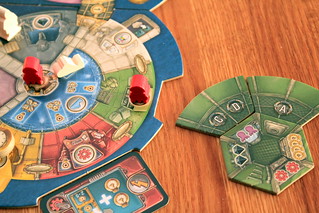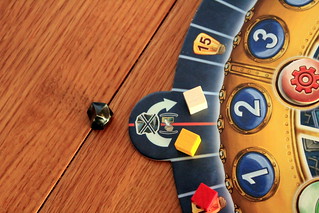| Strategy | Luck |
|---|---|
| Interaction | Components & Design |
| Complexity | Score |
More importantly, AquaSphere is about exploring Feld’s favorite part of gaming: forcing players to make agonizing decisions while dealing with randomness. For this game, he found an entirely new way to torture players. Each round, the actions you can pick together, and in what order you can pick them, change. One advantage of this approach, for people who don’t enjoy winning or losing by luck, is that it’s the same randomness for everyone, and the winner is whoever dealt with it better. How does that work? AquaSphere is played on two boards, the Research Station where your Scientist walks around working, and the Headquarter where your Engineer moves to select actions.

The Headquarter board has eight rooms, the Engineers’ starting room and seven programming rooms. Those seven rooms are set up with actions every round. Moving an Engineer into a room, you program one robot to take that action.That’s all Engineers do, move from one room to another and press a few buttons. I’ve had days like that at the office. You don’t take the action immediately, but you now have a robot for your Scientist to use in the Research Station. In one round, the bottom two rooms may have the actions to Hunt Octopods or Park Submarines. You can program a robot for one of those actions, but there is no connection between the rooms, so you cannot take the other action this turn. On the second level you might have Take Time Tokens or Take Crystals. Again you have to choose between those two, but you can get to either room from both rooms on the bottom. Not so on the top level. Depending on your choice in the middle, you can only get to two of the three actions available here. This system is quite restrictive, but if you really need an action you cannot get this round you can, once per round, pay three Time Tokens to program a robot for any of the seven actions. That opens a lot of options for you, but three Time Tokens is also quite expensive. For better planning, you can already see the room actions for next round, so even with the random setup of actions, you don’t have to be surprised by it.

With the programmed robots, your Scientist can walk around the Station and do things. Each turn, you decide between those two actions, you program a robot or you use a robot. Your Scientist can move around the Station as part of his action, as long as you can pay Time Tokens to use the airlocks. There are no other restrictions on movement. Once arrived in the sector you want, you use one of the programmed robots to do its job. Scientists are not exactly work horses in this game, either. When using a robot, a number of things happen. First, you place the robot in the sector’s control space. Whoever took the last action in a sector controls it, controlling the most of the six sectors at the end of a round scores some points. The robot that controlled the sector before, even if it was your own, is displaced to the Loading Station. If the Loading Station is full, robots there are returned to their owners player board, which is bad for them because every unoccupied robot space on the player board is also worth points. Then, finally, you take the action, quite often the shortest part of your turn.
Most actions simply let you take some sort of resource. You might take all Time Markers from your current sector. Or better, as many as you can store, because you have a very limited capacity for everything. Another actions lets you take Crystals. These mysterious things, one of the main research subjects on the station, are worth some points after each round, but they have a much more important use: paying a crystal is the only way to cross the red lines on the score track. If you arrive at one of them, no matter how many more points you should get, if you can’t or won’t pay a crystal you cannot move on. Next, with yet another action, you may take a Research Card. Those come in different flavors. Some give you an additional benefit for programming or using a specific action. You might get Time Markers, points or even a Crystal every time you program Catch Octopodes, for instance. Needless to say, having those cards have an impact on your strategy, you want to harvest that benefit as often as possible. Other cards can give you a special ability – being able to cross through the center of the station to the opposite sector is very nice – an immediate resource boost or a one time benefit.

The last type of resource to take with an action are expansions to your private lab. This is where you store your stuff, and expanding your lab in the right way is very important. In your small, basic lab you may store four Time Tokens, two Crystals and two Research Cards and you may catch two octopodes at a time. You can not pick up more of anything than your lab capacity, not even to take resources away from your opponents. By adding an expansion to your laboratory, you can increase your capacity for one or two of those things. Also on the lab expansions, you find letters from A to F. When taking an expansion with a letter, you may immediately place a robot in the control room of the corresponding sector. Having as many letters as possible also gives you a considerable point boost at the end of the game.
That leaves three actions that are not to take any type of resource. Parking a submarine is the only action you have to pay for, it costs you more Time Markers the more submarines are already in that sector’s hangar. On the other hand, each submarine placed gives you a Time Marker after each round, so they sort of pay for themselves. Having more submarines placed also lets you score more points for robots not on your player board, and having them all placed scores a small bonus at the end of the game. Why you have to catch octopodes, the next action, is not entirely clear to me, I’m quite fond of these smart creatures. But apparently they are a nuisance on the station, mess with peoples’ research, steal their sandwiches and quite possibly drive up the Internet bill googling for tentacles, so they have to go. Catching octopodes is worth points, more points if you can catch many at once, but there is another good reason to get rid of them: having them in a sector you control actually costs you points. They are an interesting consideration when taking control of the sector: will you be able to get rid of them, or is your action worth more than the points you will lose if you cannot.

The final action is what you might call meta-programming, and where the difference between a good AquaSphere player and an excellent one is made. You use a robot to program another robot. Each sector has a different action printed on, and you can use this action to program a robot for that action. Action number seven, the programming action, is not available this way. That would be too meta. You won’t usually be using this action much, maybe once or twice in a game, but doing so at the right time can make a big difference. You can use this action to program a robot for an action you desperately need, but it’s cheaper than paying three Time Markers for programming any action. Those Markers can still be used for airlocks or placing submarines.
With your Engineers only able to move in one direction, your number of actions per round is limited by the number of robots you can program. Sooner or later, you will have to pass.You don’t have to use all your robots first, you can pass and keep programmed robots for the next round, after resources are restocked. Passing early also means moving early on the next round, a benefit with no downsides in AquaSphere. Once all players have passed there is an intermediate scoring, new resources are put on the Station in a way that is also random but predictable. Repeat for four rounds, and that’s it.
Now, we don’t have to talk about the realism of the game. Engineers only being able to program for three different actions per round, essentially decided by a card draw, is not at all unrealistic. I’m a programmer myself. We do come up with weird stuff like that to make office work more interesting and make sure our bosses can’t figure out what it actually is we’re doing all day. But Scientists only being able to do their job with robots remotely programmed for one specific task, that seems far-fetched. Realism aside, the two step way you take actions – program, then execute – sounds convoluted. It does indeed take some getting used to, but it works. Programming the robots as a step separate from taking actions makes it easier to deal with the strict order of programming actions, and it lets you carry actions from one round to the next. After just two or three turns, everyone understands how the system works and most moves are very quick.

Except for sometimes, when players have to agonize over their decisions. It’s a mark of Feld’s games that you can never get everything you want, or even everything you need, and you’ll have to make tough decisions about what you need most. In AquaSphere, which actions to program and when and where to use them is often a tough decision and sometimes you’ll have to wait for someone to grind through all the painful consequences of what they are about to do. But even then, the game flows well.
I didn’t like some of Feld’s recent games so much because, in my opinion, they went too far to the luck side in his search to balance luck with strategy. Not so with AquaSphere, it leans much more towards the strategy side. It’s even debatable if you can talk about luck in this game. There is randomness, but most of it affects all players equally. Only the available Research Cards and Lab Expansions might be better for some players than others, if they just happen to fit your strategy or not. Finally, I like the interaction with other players. You don’t trade or negotiate anything, but you compete for very limited resources and you can make a pretty good guess what your opponents’ are aiming for, since you can see how they program their robots. All that adds up to a very interesting, strategic game and my personal favorite Feld game since Macao.















